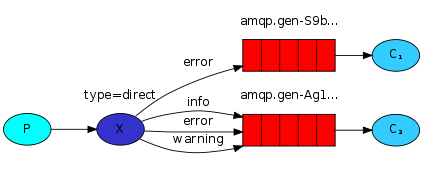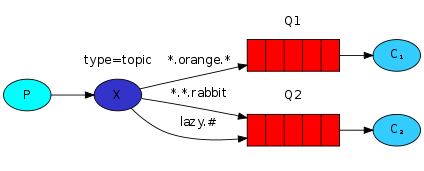RabbitMQ消息队列
rabbitmq可以维护很多的队列
#producer生产者 import pika #建立socket connection = pika.BlockingConnection( pika.ConnectinParameters('localhost') ) #声明管道,在管道里发消息 channel = connection.channel() #在管道里声明队列 channel.queue_declare(queue='hello') #正式发消息 channel.basic_publish(exchange='', routing_key='hello', #queue的名字 body='Hello World!') # 消息内容 print("[x] Sent 'Hello World!'") connection.close() #关闭队列
#consumer消费者 import pika #建立连接 connection = pika.BlockingConnection(pika.ConnectionParameters( 'localhost')) #建立管道 channel = connection.channel() #声明队列 channel.queue_declare(queue='hello') #producer中已经声明过一个消息队列了,为什么还要声明一个? 因为我们不确定哪个生产者先运行,哪个消费者先运行,如果生产者先运行,那么不写这一句也可以,但如果不写这一句并且是消费者
先运行,就会报错,为了不报错,所以两者都声明。如果声明的这个queue已经存在了,就什么也不做,直接返回。 def callback(ch, method, properties, body): #ch 声明的管道对象内存地址 print('-->', ch,method,properties) print("[x] Received %r" % body) #消费消息 channel.basic_consume(callback, #如果收到消息,就调用callback函数处理消息 queue='hello', #从哪个队列中收消息 no_ack=True) # 不管消息处理还是没有处理完,都不会给服务器端发确认消息 print(' [*] Waiting foe message,To exit press CTRL+C') channel.start_consuming()
一个生产者对应多个消费者
RabbitMQ消息分发轮询
模拟消费者接收消息中断
#producer生产者 import pika connection = pika.BlockingConnection( pika.ConnectinParameters('localhost') ) channel = connection.channel() channel.queue_declare(queue='hello') channel.basic_publish(exchange='', routing_key='hello2', body='Hello World!') print("[x] Sent 'Hello World!'") connection.close()
#consumer消费者 import pika import time connection = pika.BlockingConnection(pika.ConnectionParameters( 'localhost')) channel = connection.channel() channel.queue_declare(queue='hello2') def callback(ch, method, properties, body): print('-->', ch,method,properties) time.sleep(30) print("[x] Received %r" % body) channel.basic_consume(callback, queue='hello', no_ack=True) #rabbitmq默认就会消息发送完毕就会确认 print(' [*] Waiting foe message,To exit press CTRL+C') channel.start_consuming()
流程:生产者发送消息,被消费者收到,消费者处理完后,会自动给生产者发送确认,说这个消息处理完了,生产者才会把这个消息从队列中删除,
只要没有收到确认就不会删除,中间消费这个消息的消费者如果突然断掉了,生产者检测到后就会自动轮询到下一个,就代表还是一个新的消息。
D:Program Files (x86) abbitmq_server-3.6.5sbin>rabbitmqctl.bat list_queues #可以查看当前有多少个queue,并且每个queue中的消息有多少 Listing queue ... hello 0 hello 1 #等消费者处理完后消息就会变为0
rabbitmq的持久化
#客户端,服务器端都需要写
channel.queue_declare(queue='hello',durable=True) #只持久化队列的名字,但是里面的消息还是会消失
但是在发消息端加上下面的内容就可以使消息也持久化
channel.basic_publish(exchange='', routing_key='task_queue', body=message, properties=pika.BasicProperties( delivery_mode=2, #使消息持久化 ))
如果队列的名字没有持久化,但是消息持久化了,会出现什么效果?
在消费者端如下
#consumer消费者 import pika import time connection = pika.BlockingConnection(pika.ConnectionParameters( 'localhost')) channel = connection.channel() channel.queue_declare(queue='hello2') def callback(ch, method, properties, body): print('-->', ch,method,properties) time.sleep(30) print("[x] Received %r" % body) channel.basic_qos(prefetch=1) #处理完一条再发下一条
channel.basic_consume(callback, queue='hello', no_ack=True) print(' [*] Waiting foe message,To exit press CTRL+C') channel.start_consuming()
生产者发一条消息,所有的消费者都收到,这就要用到exchange,exchange是一个转发器
主要有几种类型
fanout:所有绑定到这个exchange的queue都可以接收消息
direct:通过routingKey和exchange决定哪个唯一的queue可以接受消息
topic:所有符合routingKey(此时可以使一个表达式)的routingKey所bind的queue可以接受消息
headers:通过headers来决定把消息发给哪些queue (用得少)
RabbitMQ fanout广播模式
订阅发布模型类似于收音机,开着收音机就能收到,关闭收音机就收不到消息
生产者
#因为是广播,所以不需要声明queue import pika import sys connection = pika.BlockingConnection(pika.ConnectionParameters(host='localhost')) channel = connection.channel() channel.exchange_declare(echange='logs',type='fanout) message = ' '.join(sys.argv[1:]) or "info: Hello World!" #调用命令行自己输入消息,如果没有输入,就是后面的消息 channel.basic_publish(exchange='logs',routing_key='',body=message) #routing_key为空,代表queue名为空 print(" [x] Sent %r" % message) connection.close()
消费者
import pika connection = pika.BlockingConnection(pika.ConnectionParameters(host='localhost')) channel = connection.channel() channel.exchange_declare(exchange='logs',type='fanout') result = channel.queue_declare(exclusive=True) #exclusive排他的,唯一的,不指定queue名字,rabbit会随机分配一个名字,exclusive=True会在使用此queue的消费者断开后,自动将queue删除 queue_name = result.method.queue #拿到queue的名字
channel.queue_bind(exchange='logs',queue=queue_name) #绑定到转发器上,从哪个转发器上收 #消费者只会从queue里接收消息,所以消费者是拿个queue去绑定exchange,而不是直接从exchange接收,这就是有queue的原因 print(' [*] Waiting for logs, To exit press CTRL+C') def callback(): print(' [x] %r' % body) channel.basic_consume(callback,queue=queue_name,no_ack=True) channel.start_consuming()
RabbitMQ direct广播模式
有选择的接收消息,RabbitMQ支持根据关键字发送,队列绑定关键字,发送者将数据根据关键字发送到消息exchange,exchange根据关键字判定应该讲述发送至指定队列

#生产者 import pika import sys connection = pika.BlockingConnection(pika.ConnectionParameters(host='localhost')) channel = connection.channel() channel.exchange_declare(exchange='direct_logs',type='direct') severity = sys.argv[1] if len(sys.argv) > 1 else 'info' #级别 message = ' '.join(sys.argv[2:]) or 'Hello World!' #消息 channel.basic_publish(exchange='direct_logs',routing_key=severity,body=message) #routing_key=severity把消息全都发到severity这个级别里 print(' [X] Sent %r:%r' % (severity,message)) connection.close()
#消费者 import pika import sys connection = pika.BlockingConnection(pika.ConnectionParameters(host='localhost')) channel = connection.channel() channel.exchange_declare(exchange='direct_logs',type='direct') result = channel.queue_declare(exclusive=True) queue_name = result.method.queue severities = sys.argv[1:] #获取执行这个脚本的所有参数,获取的是列表 if not severities: sys.stderr.write('Usage: %s [info] [warning] [error]' % sys.argv[0]) for severity in severities: #循环此列表绑定,每个参数都绑定到这个exchange上 channel.queue_bind(exchange='direct_logs',queue=queue_name,routing_key=severity)
def callback(ch,method,properties,body):
print('[x] %r:%r' % (method,routing_key,body))
channel.basic_consume(callback,queue=queue_name,no_ack=True)
channel.start_consuming()
RabbitMQ topic细致的消息过滤广播模式
如果要做一个更细致的区分,例如把应用程序也区分等,更细致的过滤

#生产者 import pika import sys connection = pika.BlockingConnection(pika.ConnectionParameters(host='localhost')) channel = connection.channel() channel.exchange_declare(exchange='topic_logs',type='topic') routing_key = sys.argv[1] if len(sys.argv) > 1 else 'anonymous.info' message = ' '.join(sys.argv[2:]) or 'Hello World!' channel.basic_publish(exchange='topic_logs',
routing_key=routing_key,
body=message) print(' [x] Sent %r:%r' % (routing_key, message)) connection.close()
#消费者 import pika import sys connection = pika.BlockingConnection(pika.ConnectionParameters(host='localhost')) channel = connection.channel() channel.exchange_declare(exchange='topic_logs',type='topic') result = channel.queue_declare(exclusive=True) queue_name = resule.method.queue binding_keys = sys.argv[1:] if not binding_keys: sys.stderr.write('Usage: %s [bindging_key]... ' % sys.argv[0]) sys.exit(1) for binding_key in binding_keys: channel.queue_bind(exchange='topic_logs', queue=queue_name, routing_key=binding_key) print(' [*] Waiting for logs. To exit press CTRL+C') def callback(ch, method,properties,body): print(' [x] %r:%r' % (method,routing_key,body)) channel.basic_consume(callback, queue=queue_name, no_ack=True) channel.start_consuming()
RPC
目前的消息流是单向的,如果想给远程的机器发送命令,使其执行完后并返回,这种模式是rpc
#客户端 import pika import uuid class FibonacciRpcClient(object):
def __init__(self): self.connection=pika.BlockingConnection(pika.ConnectionParameter(host='localhost'))
self.channel=self.connection.channel()
result=self.channel.queue_declare(exclusive=True)
self.callback_queue=result.method.queue # 一个随机queue
self.channel.basic_consume(self.on_response, # 只要一收到消息就调用on_response函数
no_ack=True,
queue=self.callback_queue) #收self.callback_queue
def on_response(self, ch, method, props, body):
if self.corr_id == props.correlation_id: # 发出去的命令就是想要的结果
self.response = body
def call(self, n):
self.response = None
self.corr_id = str(uuid.uuid4()) #
self.channel.basic_publish(exchange='',
routing_key='rpc_queue',
properties=pika.BasicProperties(
reply_to=self.callback_queue, #让服务器端执行完命令后,把结果返回到callback_queue
correlation_id=self.corr_id, #
),
body=str(n)) # 发送的消息
while self.response is None:
self.connection.process_data_events() #非阻塞版的start_consuming(),有消息就接收消息,没消息就继续往下走,收到消息就会触发on_response(),on_response()把
self.response = body,所以response就不为None了,等下次while self.response is None就不成立了,也就不再接收
return int(self.response) fibonacci_rpc = FibonacciRpcClient() print(' [x] Requesting fib(30)') response = fibonacci_rpc.call(30) # 调用call方法,传参数 print(' [. ] Got %r' % response)
#服务器端 #先接收消息,然后把执行结果返回 import pika import time connection = pika.BlockingConnection(pika.ConnectionParameters(host='localhost')) channel = connection.channel() channel.queue_declare(queue='rpc_queue') #服务端要从rpc收消息,先声明一个rpc_queue def fib(n): if n == 0: return 0 elif n == 1: retun 1 else: return fib(n-1) + fib(n-2) def on_request(ch,method,props,body): #收到消息,执行命令,然后返回结果 n = int(body) #收到的消息 print(' [. ] fib(%s)' % n)
response=fib(n) # 得到fib()函数的执行结果 ch.basic_publish(exchange='', routing_key=props.reply_to, #服务器端拿到fib()函数的执行结果然后返回给客户端, properties=pika.BaiscProperties(correlation_id= props.correlation_id), body=str(response))
ch.basic_ack(delivery_tag=method.delivery_tag) #确保消息被消费了,任务完成,结果返回给客户端
channel.basic_consume(on_request, queue='rpc_queue')
#basic_consume接收这个消息,on_request是调用on_request()函数,从rpc_queue中接收
print(' [x] Awaiting RPC requests')
channel.start_consuming()
Redis
单线程,通过epoll实现高并发